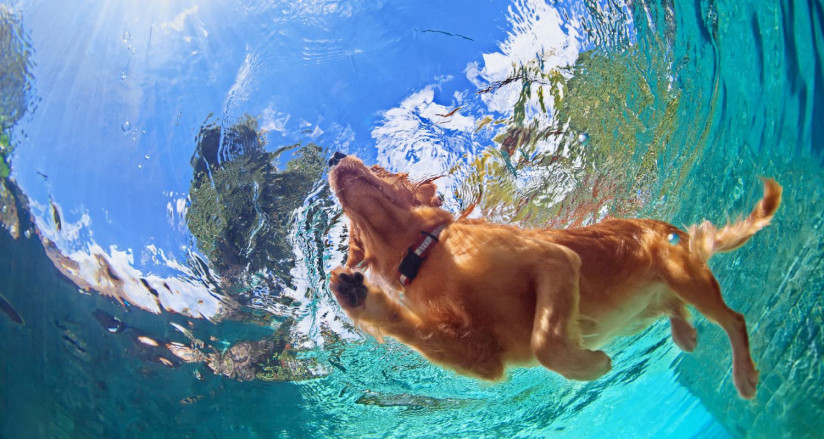A dip in a swimming pool is the perfect way for your dog to exercise and beat the summer heat, but there are hidden dangers that may not be obvious to pet parents. Many dogs drown each year from avoidable pool accidents.
The Basics
There are always exceptions, but short-tailed breeds (Boxers, Bulldogs, and Pugs) and most dogs with dense muscles and large heads (Pekingese, Staffordshire Bull Terriers, Bassett Hounds, Dachshunds) are not great swimmers. Always keep an eye on your dog of any breed around the pool and lock your pool gates when the dog is left unattended.
Learning to Swim
It’s important to teach your dog – puppies included – how to swim and safely exit backyard pools and other bodies of water. Dogs will typically try to exit water the way they came in, and inexperienced swimmers can even drown from exhaustion if they fall in while at play.
Start Slowly
Begin by offering treats and toys from the water’s edge, luring your dog closer to the water until they are ready to get their paws wet. In a kiddie pool, do this until your dog is happy to stand in a few inches of water; add more at each subsequent session until the water is as deep as you need it to be. If your pet goes to the edge but isn’t ready to get in the water, try calling them into your arms, or simply pick them up and bring them in with you. Do not proceed if you sense tension. If they remain calm, walk into the POOL SAFETY FOR DOGS water with their head above the waterline. Speak in a soothing voice to help keep them relaxed.
Avoid Surprises
Never throw, push, or drop your dog into the water. It can be startling and scary even to experienced swimmers, and create serious water phobias in inexperienced ones.
Entering and Exiting
Your dog will instinctively try to exit a body of water from the point of entry. To teach them how to exit a pool:
1. Attach a recall leash to their collar.
2. Gently place your dog in the pool from the steps. They will instinctively turn around to exit from the point of entry. Repeat this several times.
3. Once your dog learns they can exit the pool from the steps, progress to other areas of the pool. Gently place or guide your dog in the water, then use the recall leash to guide them to the step area, giving as little help as necessary. Even if your dog is an avid swimmer, it’s still a good idea to refresh their memory of the step location at least every four months.
Teaching Poolside Behavior
Being in the water is only half of the equation. Poolside etiquette is equally important to in-pool manners.
The Basics
Teaching your dog how to behave while lounging or playing poolside is as important as in-pool manners – some pet parents may only want their dog in the pool in certain situations, if at all. First, observe your dog while a family member is in the pool so you can clearly see and address unwanted behaviors.
Learning Poolside Manners
Distractions abound around pools, and many dogs can struggle. Several common poolside behaviors often need to be addressed with training, including:
1. Permission. Your dog should learn that they cannot enter the pool without your permission.
2. Barking or lifeguarding. Some dogs will bark, chase, or even jump in while people are swimming.
3. Boundaries. Not all pet parents want their dogs in or around the pool or other bodies of water… and that’s okay! Boundary education helps pets learn where they are or are not allowed to venture.
Additional Safety Tips
Keep Keep an Eye Out for Exhaustion
Some dogs will chase a ball or a Frisbee again and again until they nearly collapse. This is because they are not capable of understanding exhaustion, especially when adrenalized by play. Games of fetch are a little less exhausting on land, however, because there is always a solid place to lie down and rest. Swimming can be just as tiring as dry-land playtime, if not more tiring, so keep an eye out for signs of exhaustion, like flailing in the water or not wanting to swim after a toy. Limit your dog’s time in the water and take regular breaks. If you observe signs of exhaustion, stop playtime to allow your dog to recover.
Protect Paws and Skin from Burns
All dogs – especially those with light-colored coats – can experience sunburn, which can lead to skin cancer. Ask your veterinarian about pet-safe sunblock. Poolside surfaces can get extremely hot in the sun. Dogs rely on the sweat glands in their paw pads to cool down and may become more susceptible to heatstroke on hot ground. Place the palm of your hand on the surface – if it feels hot to the touch, it’s too hot for your dog’s paws.
Give It a Rinse
Rinse your dog off after a swimming session, as chlorine dries out skin and fur and can cause your pet to itch and scratch in discomfort. This is especially important after swimming in a lake, pond, or river to avoid ear mites, eye infections, and insects which can embed themselves into dog fur and hair.
Use a Floatation Device in Deep or Open Water
A vet-approved life preserver for dogs is a useful accompaniment for excursions into deep, open waters. Practice in your pool so your dog becomes comfortable wearing, walking, and swimming in a lifejacket before moving on to bigger bodies of water.
Say No to Hot Tubs
While hot tubs can be a great way for humans to relax, they are not safe for dogs.
With a little preparation, time at the pool can be fun for everyone. Talk to your local Bark Busters trainer for questions, consultation, and lessons to help your dog stay safe around water.
